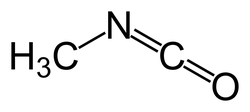What is MIC?
Methyl Isocyanate, known as MIC, is a clear, colorless liquid used for the creation of pesticides. It has also been used to create rubber. MIC is a lachrymatory agent, meaning it has the same effects as tear gas. It is extremely toxic.
MIC is safe when maintained properly. The chemical is highly reactive to heat. When exposed to water, the compounds in MIC react with each other causing a heat reaction. Even the smallest amount of water creates pressure, turning MIC from a liquid to a gas.
MIC is safe when maintained properly. The chemical is highly reactive to heat. When exposed to water, the compounds in MIC react with each other causing a heat reaction. Even the smallest amount of water creates pressure, turning MIC from a liquid to a gas.
MIC Today
Methyl Isocyanate is no longer in production, although it is still used in pesticides. The Bayer CropScience plant in Institute, West Virgina is currently the only storage location of MIC left across the globe. In 2008, Bayer CropScience plant experienced an explosion that killed two employees. The explosion happened 80 feet away from the MIC storage tanks. As a result, Bayer announced plans to spend $25 million to reduce the amount of MIC stored by 80% and move the rest to an underground location.
Health Effect of MIC
Immediate Health Effects (0-6 months)
Long Term Health Effects
- Ocular: chemosis, redness, watering, ulcers, photophobia
- Respiratory:distresss pulmonary edema, pneumonitis, pneumonthorax
- Gastrointestinal: persistent diarrhea, anorexia, persistent abdominal pain
- Genetic: increased chromosomal abnormalities
- Psychological: neuroses, anxiety states, adjustment reactions
- Neurobehavioral: impaired audio and visual memory, impaired vigilance attention and response time, impaired reasoning and spatial ability, impaired psychomotor coordination
Long Term Health Effects
- Ocular: persistent watering, corneal opacities, chronic conjunctivitis
- Respiratory: obstructive and restrictive airway disease, decreased lung function
- Reproductive: increased pregnancy loss, increased infant mortality, decreased placental/fetal weight
- Genetic: increased chromosomal abnormalities
- Neurobehavioral: impaired associate learning, motor speed, and precision


